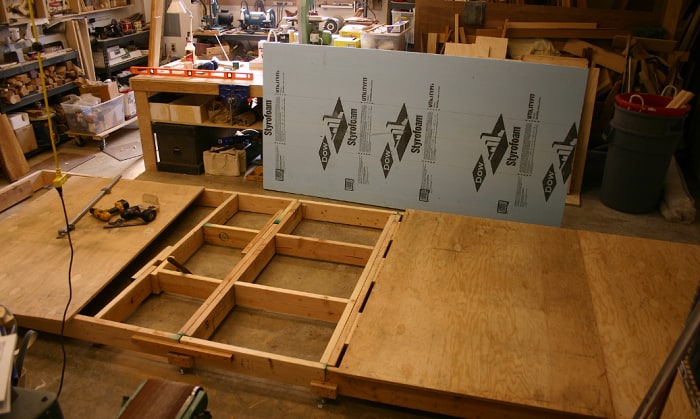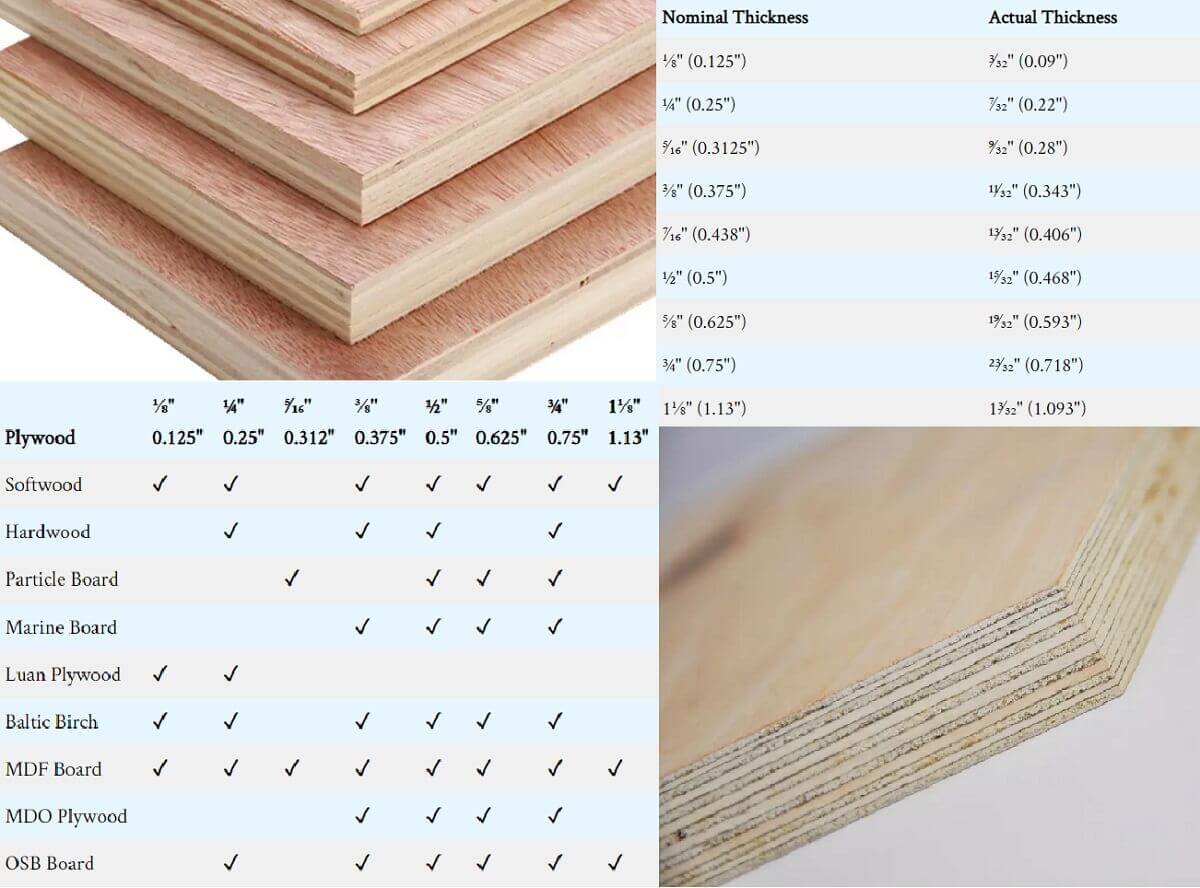If you’re wondering “what size plywood for boat floor?” you’ve come to the right place! Choosing the right plywood size for your boat floor is essential for stability and durability. In this article, we’ll discuss the different factors to consider and help you make an informed decision. So let’s dive in and find the perfect plywood size for your boat floor!
When it comes to the size of plywood for boat flooring, there are a few key points to keep in mind. First and foremost, you’ll want to consider the dimensions of your boat and the area that needs to be covered. The thickness of the plywood is another crucial factor to ensure it can withstand the weight and pressure without sagging or flexing.
The type of wood used for the plywood is also significant. Marine-grade plywood, such as Okoume or Meranti, is a popular choice due to its water-resistant properties. It’s essential to select a plywood size and thickness that suits the specific requirements of your boat, ensuring safety and longevity. Now, let’s explore all the details to help you find the perfect size plywood for your boat floor!

What Size Plywood is Best for Boat Flooring?
When it comes to boat flooring, choosing the right size plywood is crucial. The plywood used for boat flooring needs to be strong, durable, and able to withstand the harsh marine environment. In this article, we will explore the factors to consider when determining the size of plywood for boat flooring, as well as provide some helpful tips to ensure you make the right choice. Whether you have a small fishing boat or a larger yacht, understanding the importance of plywood size will help you make informed decisions for your vessel.
1. Boat Size and Weight Capacity
The size of your boat plays a significant role in determining the size of plywood needed for the flooring. Boat flooring should be able to support the weight of the occupants, as well as any additional equipment, without compromising the structural integrity of the vessel. Smaller boats may require a thinner plywood, such as ⅜ or ½ inch, whereas larger boats may necessitate thicker plywood, such as ¾ inch. Consider the weight capacity of your boat and consult manufacturer guidelines to determine the appropriate plywood thickness.
It’s important to note that marine-grade plywood is highly recommended for boat flooring due to its superior strength and resistance to moisture. This type of plywood is specifically designed for use in marine environments and is constructed using waterproof adhesive, making it less susceptible to rot and delamination.
2. Floor Support Structure
The support structure of your boat floor also dictates the size of plywood required. Depending on the boat’s design, the flooring may be supported by stringers, ribs, or bulkheads. These support structures enhance the overall strength and stability of the boat, ensuring the plywood remains securely in place. Understanding the spacing and layout of these support structures will help determine the appropriate size of plywood needed.
If your boat has larger spacing between supports, you may opt for thicker plywood to ensure adequate weight distribution and avoid flexing or bouncing of the flooring. Conversely, boats with closely-spaced supports may allow for thinner plywood without sacrificing structural integrity. Always consult the boat manufacturer’s guidelines or seek professional advice to ensure you select the correct plywood thickness for your specific support structure.
3. Desired Flooring Type
Another factor to consider when determining the size of plywood for boat flooring is the type of flooring you plan to install. Different flooring materials have varying thickness requirements. For example, if you plan to install carpet or vinyl flooring, you may require thinner plywood compared to if you opt for a thicker and heavier material like hardwood.
Consider the weight, flexibility, and installation requirements of your chosen flooring type to ensure it aligns with the plywood size. Some flooring materials may also warrant additional layers or underlayment, which can impact the plywood thickness needed. Research the specifications and requirements of your desired flooring type to make an informed decision about the size of plywood required.
4. Finishing and Edging Considerations
When selecting the size of plywood for boat flooring, it’s essential to account for any finishing and edging details. Finishing techniques, such as beveled or rounded edges, can impact the effective size of the plywood panels. Additionally, if you plan to install trim or molding along the edges of the flooring, ensure you factor in the dimensions of these components when determining the appropriate plywood size. Proper planning and measurement of finishing details will result in a clean and professional-looking installation.
Furthermore, consider any additional cutouts or openings required for access to boat components, such as hatches or storage compartments. These cutouts may necessitate smaller plywood sections within the overall flooring system. Take accurate measurements and consult the boat’s design plans or specifications to ensure precise and optimal placement of the cutouts.
5. Cost and Availability
While ensuring the appropriate size of plywood for your boat flooring is paramount, it’s also essential to consider the cost and availability of the materials. Thicker plywood tends to be more expensive, and the availability of certain sizes may vary depending on your location or supplier. Balancing your budget with the structural requirements of your boat will help you make a practical and cost-effective choice.
Compare prices from different suppliers and consider the overall cost of the project, including any additional materials or tools required for installation. Don’t compromise on the quality and suitability of the plywood, but also keep in mind the financial aspect of the decision. In some cases, it may be worthwhile to consult a marine construction professional or boatyard to ensure the best combination of quality and cost.
Conclusion:
In conclusion, choosing the right size plywood for boat flooring is crucial for the structural integrity and overall performance of the vessel. Factors such as boat size, support structure, flooring type, finishing details, and cost should all be taken into consideration when making this decision. By understanding these factors and consulting professional advice when needed, you can confidently select the appropriate plywood size that will provide a strong and durable foundation for your boat’s flooring.
Key Takeaways: What Size Plywood for Boat Floor?
- 1. Plywood for boat flooring should have a minimum thickness of 3/4 inch.
- 2. Marine-grade plywood is highly recommended for boat floors due to its water resistance.
- 3. The size and number of plywood sheets needed depend on the boat’s dimensions and design.
- 4. Consult boat manufacturers or experts for specific recommendations on plywood size.
- 5. Proper sealing and waterproofing of the plywood is crucial for long-term durability and protection.
Frequently Asked Questions
When it comes to choosing the right plywood for your boat floor, there are a few important factors to consider. The size of the plywood is one of them. Here are some commonly asked questions about what size plywood is suitable for a boat floor:
Q: What factors should I consider when selecting the size of plywood for my boat floor?
When choosing the size of plywood for your boat floor, there are a few factors to consider. Firstly, think about the size and layout of your boat. Measure the area where the plywood will be installed to ensure a perfect fit. Additionally, consider the weight-bearing capacity of the plywood. If you plan on carrying heavy loads or having multiple occupants on the boat, opt for thicker and stronger plywood.
Lastly, take into account your budget and the availability of different plywood sizes. Make sure you choose a size that fits within your budget without compromising the quality and durability of the plywood.
Q: What are some common sizes of plywood used for boat floors?
There are a few common sizes of plywood that are typically used for boat floors. One of the most popular sizes is 4 feet by 8 feet, also known as a standard sheet. This size is readily available and can be easily cut to fit the specific dimensions of your boat floor. Another common size is 3/4 inch in thickness, which provides good stability and strength for boat flooring.
However, it’s important to note that the ideal size of plywood for your boat floor may vary depending on the specific requirements of your boat and the intended usage. It’s always a good idea to consult with a professional or a marine engineer to determine the most suitable plywood size for your boat floor.
Q: Can I use plywood with a smaller size for my boat floor?
Using plywood with a smaller size for your boat floor is not recommended. The size of the plywood directly affects its structural integrity and weight-bearing capacity. Opting for a smaller size may compromise the stability and durability of the boat floor, especially if you plan on carrying heavy loads or having multiple occupants on board.
It’s crucial to choose the appropriate size of plywood for your boat floor to ensure its longevity and safety. Always consult with professionals or experts in the field to determine the right size for your specific boat and its intended usage.
Q: What are the advantages of using larger plywood sizes for a boat floor?
Using larger plywood sizes for your boat floor can offer several advantages. Firstly, larger plywood sizes provide better coverage and allow for fewer seams, resulting in a more aesthetically pleasing finish. Additionally, larger plywood sizes tend to be more stable and have higher weight-bearing capacities, making them suitable for boats that will be subjected to heavy loads or multiple occupants.
Moreover, larger plywood sizes often allow for more flexibility in terms of design and layout, giving you the freedom to create custom shapes and configurations for your boat floor. However, it’s important to ensure that the larger plywood size is compatible with your boat’s size and structure before making a decision.
Q: Can I use marine-grade plywood for my boat floor?
Yes, marine-grade plywood is commonly used for boat floors, particularly in areas that are exposed to moisture and water. Marine plywood is specifically designed and manufactured to withstand the harsh marine environment, making it resistant to rotting, warping, and delamination. It is made with waterproof glue and usually has a higher number of plies for added strength.
While marine-grade plywood can be more expensive than regular plywood, its durability and resistance to moisture make it an excellent choice for boat floors. When using marine-grade plywood, ensure it is properly sealed and treated to enhance its longevity and protect it from the elements.

Summary
So, to summarize, the size of plywood for a boat floor depends on a few factors. The thickness of the plywood should be around 1/2 inch, which is sturdy enough for most boats. However, if you have a bigger boat or plan on carrying heavy loads, you might want to go for 3/4 inch plywood. Remember to measure your boat floor accurately to ensure you get the right size. Additionally, marine-grade plywood is the best option as it is designed to withstand moisture and harsh marine conditions.
When it comes to the type of plywood, both marine-grade and exterior-grade plywood can work well. If you are on a tight budget, exterior-grade plywood is a more affordable choice. Don’t forget to seal and protect your plywood with varnish or epoxy to extend its lifespan. Investing in proper plywood for your boat floor will help keep you safe and ensure your boat stays in good condition for a long time.
